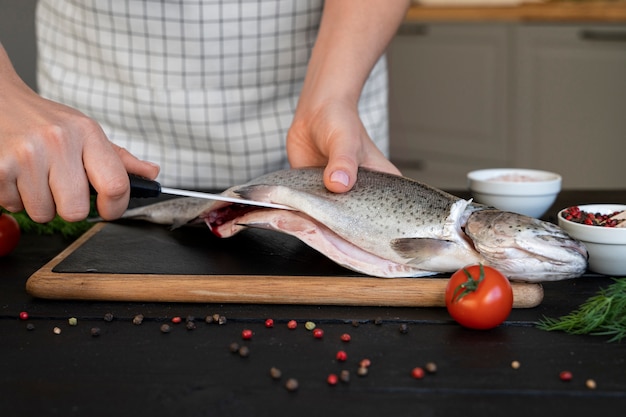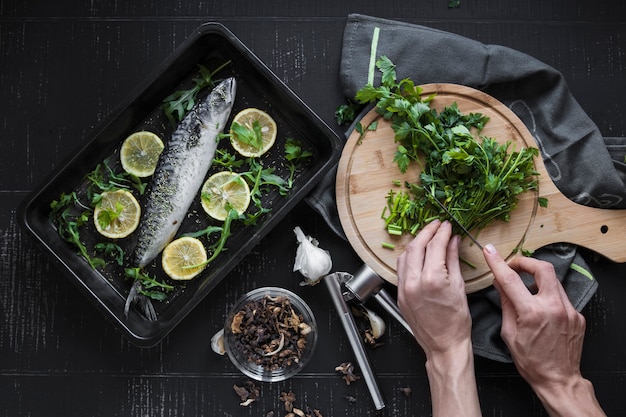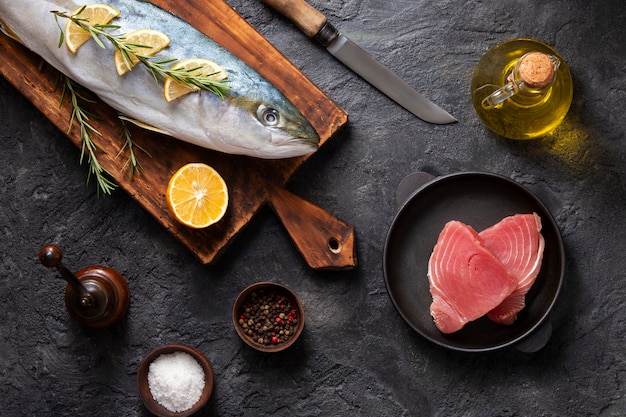Right, let's talk about yellowtail, shall we? It's a fish that has recently captured my culinary attention, and for good reason! It's so darn versatile, it can be cooked up in countless ways, each offering a unique flavour profile. From the classic sashimi experience that showcases its delicate sweetness to pan-seared perfection with a crispy crust, there's a yellowtail recipe for everyone. I'm going to share some of my personal favourites with you, along with tips and tricks I've learned along the way. So, grab a refreshing beverage, settle in, and let's dive into the wonderful world of yellowtail!
Part 1: A Deeper Dive into the Wonder of Yellowtail

A Culinary Treasure
First things first, let's unpack what makes yellowtail so special. This fish, which is actually a type of amberjack, boasts a firm, meaty texture and a delicate, almost sweet flavour. It's also packed with protein and omega-3 fatty acids, making it a healthy and delicious addition to any meal. Now, I know some people might be a bit intimidated by the idea of cooking fish, but honestly, yellowtail is so forgiving, it's practically foolproof. You really can't go wrong, which is a huge plus for any home cook!
Where to Find This culinary gem
Now, where can you find this treasure? Well, it's typically found fresh at your local fishmonger. Look for fillets that are firm to the touch, with a vibrant, almost golden colour. The fresher the fish, the better the flavour, so always ask your fishmonger about their sourcing practices. And if you're lucky enough to have a Japanese supermarket nearby, they often have beautiful yellowtail cuts ready to go, perfect for sashimi or sushi.
A Sustainable Choice
Let's be mindful of our choices, shall we? Always try to buy yellowtail from sustainable sources. Look for labels like the Marine Stewardship Council (MSC) or ask your fishmonger about their sourcing practices. It's a small step, but it makes a big difference for our oceans. Supporting sustainable fishing practices helps ensure we have plenty of delicious yellowtail to enjoy for generations to come.
Part 2: The Raw and Sublime: Yellowtail Sashimi

A Taste of Simplicity
Okay, let's start with the classic – yellowtail sashimi. It's simply sliced thin and served raw, with a touch of soy sauce, wasabi, and pickled ginger. It's a taste sensation that's best described as… pure bliss. The texture is firm yet tender, the flavour is fresh and clean, and the delicate sweetness of the fish just melts in your mouth. Trust me, it's a truly unforgettable experience.
Choosing the Right Yellowtail for Sashimi
The key to a great sashimi is the quality of the yellowtail. You want a fish that's been handled properly and hasn't been frozen for too long. Look for fillets that are bright, shimmering, and have a good amount of marbling. The marbling gives it that beautiful, almost buttery texture, which is a hallmark of high-quality yellowtail.
The Art of Slicing
Slicing sashimi is a real art form, but don't worry, it's easier than you think. You can use a sharp chef's knife or a dedicated sashimi knife. The trick is to hold the knife at a slight angle and slice through the fish in one smooth motion. If you're feeling fancy, you can try slicing the fish into different shapes, like flowers or diamonds. But even simple slices look beautiful and delicious! The most important thing is to make clean, even slices.
The Perfect Accompaniments
Here's the thing: sashimi is all about simplicity. It's the fish itself that truly shines. That's why you only need a few basic accompaniments: a bit of soy sauce (Japanese soy sauce is ideal), wasabi paste, and a small sliver of pickled ginger (gari). The ginger helps to cleanse your palate between bites, which lets you truly appreciate the delicate flavour of the yellowtail. If you're new to sashimi, don't be afraid to experiment with the amount of soy sauce, wasabi, and ginger to find what you like best.
Part 3: Beyond the Raw: Cooking with Yellowtail

The Versatility of Yellowtail
Okay, so you've experienced the wonder of raw yellowtail. Now, let's explore the joys of cooking it! Yellowtail is incredibly versatile, and it can be cooked in so many different ways, from pan-searing to grilling, baking, and even steaming. The key is to cook it gently, so it doesn't become dry. It's a delicate fish, but it's worth the care.
cooking tips for Success
Here are a few things to keep in mind when cooking yellowtail. First, it's important to cook it gently so it doesn't become dry. Second, don't overcook it – you want it to be slightly pink in the center. Overcooked yellowtail can become tough and dry, so it's important to cook it just until it's opaque. And lastly, be sure to season it well, but don't go overboard. A simple sprinkle of salt and pepper will do the trick. You don't want to overwhelm the delicate flavour of the fish.
A Note on Skin
Now, a quick word about yellowtail skin. It's actually quite delicious! It's a bit chewy, but it adds a nice layer of flavour to the fish. You can leave it on or remove it depending on your preference. Personally, I like to sear the skin for a bit of crispy texture. It's like a little bonus with each bite!
Part 4: A culinary adventure: Pan-Seared Yellowtail with Lemon-Butter Sauce
The Recipe
This is one of my absolute favourite ways to cook yellowtail. It's simple, elegant, and bursting with flavour. The pan-searing gives the fish a beautiful golden crust, while the lemon-butter sauce adds a bright and tangy touch. Plus, it's a great way to impress your friends or family. It's a dish that's easy to make but feels like a special occasion meal.
Ingredients
- 4 yellowtail fillets (about 6 ounces each)
- 1 tablespoon olive oil
- Salt and freshly ground black pepper to taste
- 1 tablespoon butter
- 2 tablespoons fresh lemon juice
- 2 tablespoons chopped fresh parsley
- 1/4 cup dry white wine (optional)
Instructions
- Pat the yellowtail fillets dry with paper towels. This will help ensure they get a nice crispy crust when pan-seared. Season generously with salt and pepper.
- Heat the olive oil in a large skillet over medium-high heat. Make sure the skillet is hot before you add the fish, otherwise it won't get that beautiful golden brown crust. Add the yellowtail fillets to the hot skillet and cook for 3-4 minutes per side, or until golden brown and cooked through. Remove the fillets from the skillet and set aside.
- Add the butter to the skillet and melt over medium heat. Add the lemon juice, parsley, and white wine (if using). The white wine adds a bit of complexity to the sauce. Cook for 1 minute, or until the sauce has thickened slightly.
- Pour the sauce over the yellowtail fillets and serve immediately. The sauce should be warm and bubbly, so don't let it sit too long.
Serving Suggestions
This dish is perfect with a side of roasted vegetables, like asparagus or broccoli. The bright flavours of the vegetables complement the delicate sweetness of the yellowtail. You can also serve it over a bed of rice or quinoa. And don't forget a nice glass of dry white wine to complement the dish!
Part 5: A Touch of Asia: Grilled Yellowtail with Ginger-Soy Glaze
A Taste of the East
Now, let's journey to the east with this delightful grilled yellowtail recipe. It's a great way to bring a little bit of Asian flair to your table. The ginger-soy glaze is both sweet and savoury, and it pairs perfectly with the grilled fish. Plus, it's so easy to make!
Ingredients
- 4 yellowtail fillets (about 6 ounces each)
- 1 tablespoon soy sauce
- 1 tablespoon honey
- 1 tablespoon grated fresh ginger
- 1 clove garlic, minced
- 1 tablespoon olive oil
- Salt and freshly ground black pepper to taste
Instructions
- In a small bowl, whisk together the soy sauce, honey, ginger, and garlic. Set aside. The glaze will thicken slightly as it sits, which is what you want.
- Pat the yellowtail fillets dry with paper towels. Season generously with salt and pepper.
- Preheat a grill to medium heat. Brush the yellowtail fillets with the olive oil. This will help prevent them from sticking to the grill and give them a nice golden brown colour. Place the fillets on the grill and cook for 3-4 minutes per side, or until cooked through. You can test the doneness by gently pressing on the center of the fish. It should be opaque and flake easily.
- Brush the fillets with the ginger-soy glaze during the last minute of grilling. The glaze will caramelize slightly on the grill, adding another layer of flavour to the fish. Remove the fillets from the grill and serve immediately.
Serving Suggestions
Serve this dish with a side of steamed rice or stir-fried vegetables. You can also garnish with a sprinkle of sesame seeds or chopped green onions for a bit of extra flavour and colour.
Part 6: A Lighter Option: Baked Yellowtail with Herbs and Lemon
Simple and Delicious
Sometimes you're in the mood for something a bit lighter and less fussy. That's where this baked yellowtail recipe comes in. It's incredibly easy to make, and the herbs and lemon give it a fresh, vibrant flavour. You can use whatever fresh herbs you have on hand – dill, parsley, thyme, and rosemary all work wonderfully.
Ingredients
- 4 yellowtail fillets (about 6 ounces each)
- 2 tablespoons olive oil
- 1 tablespoon fresh lemon juice
- 1 tablespoon chopped fresh herbs (such as dill, parsley, thyme, or rosemary)
- Salt and freshly ground black pepper to taste
Instructions
- Preheat oven to 400 degrees Fahrenheit (200 degrees Celsius).
- Pat the yellowtail fillets dry with paper towels. Place them in a baking dish.
- In a small bowl, whisk together the olive oil, lemon juice, herbs, salt, and pepper. Pour the mixture over the yellowtail fillets. This will help keep the fish moist and flavourful while it bakes.
- Bake for 15-20 minutes, or until the fish is cooked through. Serve immediately. The fish should be flaky and cooked through, but not dry.
Serving Suggestions
This dish is delicious served with a simple side salad or a bed of rice. You can also garnish with a sprinkle of fresh herbs or a squeeze of lemon juice.
Part 7: Exploring Beyond: Other Yellowtail Delights
A World of Flavour
Look, we've barely scratched the surface of what you can do with yellowtail. This fantastic fish lends itself to so many different culinary styles and techniques. Here are a few more ideas to get your creative juices flowing:
Sushi and Sashimi
Beyond the classic sashimi, yellowtail is a staple in sushi. It's often used in nigiri (a single piece of fish over a ball of rice) or maki (rolled sushi). The firm texture and delicate flavour of yellowtail make it a perfect choice for sushi. You can also find it in various sashimi platters, often alongside other fish like tuna, salmon, and mackerel.
Yellowtail Carpaccio
This Italian-inspired dish features thin slices of raw yellowtail, often seasoned with olive oil, lemon juice, salt, and pepper. It's a light and refreshing appetizer that's perfect for a summer meal. The thinly sliced yellowtail melts in your mouth, and the simple seasonings allow its natural flavour to shine through.
Yellowtail Tacos
For a casual and fun twist, try yellowtail tacos. You can pan-sear or grill the fish, then serve it in tortillas with your favourite toppings. Think cilantro, lime, pickled onions, and spicy salsa. This is a great way to enjoy yellowtail in a more informal setting.
Part 8: A culinary journey Through Flavours
The Joy of Experimentation
The beauty of cooking is that it's an ongoing journey of discovery. Don't be afraid to experiment with different flavours and techniques. Try substituting different herbs and spices, or adding a touch of chili or ginger for a bit of heat. The possibilities are endless! The more you experiment, the more you'll learn about what you like and what works best for you.
Sharing the Experience
The best part of cooking is sharing your creations with others. So invite your friends and family over for a delicious yellowtail feast! Share your tips and tricks, and enjoy the satisfaction of creating something special. There's nothing quite like sharing a meal with loved ones and seeing them enjoy what you've made.
Part 9: FAQs: Your Yellowtail Questions Answered
1. Can I Freeze Yellowtail?
While you can freeze yellowtail, it's best to avoid freezing it if you want to use it for sashimi or sushi. Freezing can affect the texture of the fish, making it a bit mushy. However, if you're planning to cook the yellowtail, freezing it is perfectly fine. Just be sure to thaw it in the refrigerator overnight before cooking.
2. How Can I Tell If Yellowtail is Fresh?
Look for fillets that are firm to the touch, with a bright, almost golden color. The flesh should be moist and have a pleasant, slightly sweet aroma. Avoid yellowtail that has a dull color or a fishy smell. These are signs that the fish is not fresh and may not taste as good.
3. How Long Can I Keep Yellowtail in the Fridge?
Fresh yellowtail should be kept refrigerated and consumed within 2 days. To extend its shelf life, you can wrap it tightly in plastic wrap and store it in the refrigerator for up to 3 days. For longer storage, freezing is an option, but keep in mind the texture may change.
4. What Are Some Good Substitutes for Yellowtail?
If you can't find yellowtail, you can substitute it with other firm-fleshed fish like amberjack, mahi-mahi, or tuna. Just be sure to adjust the cooking times accordingly. Amberjack, mahi-mahi, and tuna all have a similar texture and flavour to yellowtail, so they can be good substitutes in many recipes.
5. How Can I Cook Yellowtail Without Overcooking It?
The key to cooking yellowtail without overcooking it is to cook it gently and quickly. Use a high heat source and cook the fish for a short amount of time. You want the fish to be slightly pink in the center. A meat thermometer can be helpful to ensure the fish is cooked through but not overcooked. Overcooked yellowtail can become dry and tough, so it's important to cook it just until it's flaky and opaque.
Conclusion: Embrace the Flavour of Yellowtail
Well, there you have it. From sashimi to pan-seared perfection, yellowtail is a fish that deserves a place on your table. So, get out there, find some beautiful yellowtail, and get cooking! And don't forget to share your creations with the world! Let me know what your favourite way to cook yellowtail is, I'm always looking for new recipes to try.
Everyone is watching

How to Cook Frozen Lobster Tails Perfectly: A Step-by-Step Guide
RecipesLobster. Just the word conjures up images of lavish meals, special occasions, and a taste of luxury. But let's...

Pigs in a Blanket Cooking Time: How Long to Bake for Perfect Results
RecipesAh, pigs in a blanket. Just the name conjures up images of those delightful little parcels of crispy pastry en...

Pork Fillet Cooking Time: How Long to Cook It Perfectly
RecipesPork fillet, or tenderloin as it's sometimes called, is a real favourite in our house. It's so versatile, and...

The Ultimate Guide to Cooking Delicious Frankfurters
RecipesLet's face it, we all love a good frankfurter. It's a classic, simple, and always satisfying. But let's be rea...

Wolf Meat Recipes: A Guide to Cooking Wild Game
RecipesLet's be honest, you don't see wolf meat at your local butcher shop every day. It's a bit of a wild card, but ...
